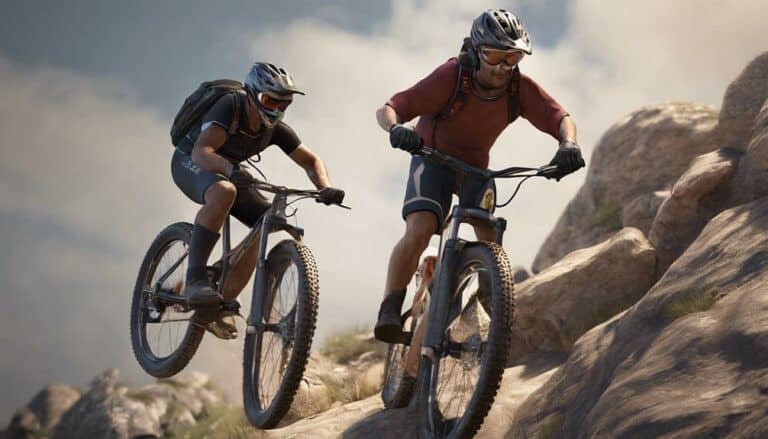Imagine yourself riding through a steep, rocky trail, feeling the challenge of maintaining balance and control on the rugged terrain. You can almost taste the victory of conquering those hills.
But how can you enhance your skills to handle such demanding landscapes with finesse? By putting into practice a few key strategies and exercises, you can greatly boost your ability to navigate hilly terrains with confidence and precision.
Key Takeaways
- Engage core stability for better balance and weight distribution on challenging terrain.
- Adjust body position for uphill control by shifting weight forward and keeping hands relaxed.
- Drop heels, bend arms and legs, and scan the trail for stability on downhill descents.
- Strengthen core muscles to enhance stability and power output during hill climbs.
Balance Exercises for Off-Road Riders
To enhance your balance and control while riding off-road on hilly terrain, incorporating specific exercises targeting core stability, leg strength, and proprioception is essential.
Balance exercises play an important role in improving your stability on the mountain bike. Activities like Bosu ball squats and single-leg movements challenge your body weight distribution, forcing your core and leg muscles to engage for stability.
Core stability exercises, such as stability ball planks, not only strengthen your core but also engage your shoulders and stabilizing muscles, essential for maneuvering uneven surfaces with finesse.
Leg strength exercises like step-ups with dumbbells target the lower-body muscles, enhancing your leg strength and stability for better control during uphill and downhill rides.
Additionally, yoga poses like the Tree Pose can significantly improve your proprioception, concentration, and body awareness, ultimately refining your balance and control skills on challenging trails.
Techniques for Uphill Riding Control
When riding uphill on hilly terrain, maintaining control and stability is fundamental for a smooth ascent. To help you enhance your balance and control while climbing, consider the following techniques:
- Scan the uphill trail: Anticipate changes in terrain to adjust your body position accordingly, enhancing balance and control.
- Light hands on handlebars: Keep your hands relaxed and wrists slightly dropped to avoid unintentional steering movements.
- Shift chest forward: Increase traction over the front wheel by shifting your chest forward, maintaining a stable climbing position.
- Adjust hip position: Optimize weight distribution by adjusting your hip position in the saddle based on the steepness of the hill, improving climbing efficiency.
- Maintain momentum and cadence: Consistently pedal with the right cadence to keep momentum and guarantee a steady, controlled ascent over hilly terrain.
Maintaining Balance on Downhill Descents
Enhance your stability and control on downhill descents by focusing on specific body positioning techniques. When tackling steep descents on your bike, remember to drop your heels to resist braking forces, hence maintaining stability and control. This technique allows you to better navigate the terrain without losing balance.
Additionally, keeping your arms and legs slightly bent helps you react more effectively to the bumps and obstacles you encounter. Shifting your hips back slightly can also contribute to your balance and control on downhill slopes, preventing you from feeling top-heavy on the bike.
To guarantee ideal weight distribution and stability, keep your chin over the stem of the bike. This simple adjustment can make a significant difference in how balanced you feel while descending. Moreover, feathering your brakes and scanning the trail ahead are essential practices for maintaining control and adapting to the changing terrain.
Core Strength for Hill Climb Stability
Improving your core strength is fundamental for maintaining stability and control during hill climbs, enabling you to navigate varied terrain with ease and efficiency. A strong core plays a vital role in your ability to tackle uphill sections effectively. Here are some key points to take into account:
- Engaging your core muscles supports your spine and pelvis, aiding in better weight distribution and balance on challenging climbs.
- Enhanced core stability allows you to generate power through the pedals more efficiently while keeping your bike steady on steep inclines.
By incorporating core-strengthening exercises into your training routine, you can greatly improve your balance, coordination, and overall performance on hilly terrain.
- Working on your core strength not only reduces the risk of fatigue and injury but also provides a stable platform for smoother pedaling.
- A Mountain Bike Instructor can guide you on specific core-strengthening exercises tailored to enhance your hill climb stability, ensuring you conquer challenging terrain with confidence.
Improving Control Through Body Position
How can you effectively achieve balanced body position for ideal control when tackling hilly terrain on a mountain bike?
Maintaining control on varied terrain hinges on your body position. To make sure stability, focus on adjusting weight distribution between your front and rear wheels.
When descending, drop your heels, keep your arms and legs bent, and shift your hips back as necessary.
Uphill, scan the trail ahead, adjust your hand and wrist position, and shift your weight forward for better traction.
Conclusion
To sum up, by incorporating balance exercises, focusing on uphill and downhill riding techniques, strengthening core stability, and improving body position, riders can enhance their balance and control when tackling hilly terrain.
Practice these techniques consistently to build confidence and enjoy a smoother riding experience on challenging landscapes.
Remember, balance and control are key components for successfully handling hilly terrains.

